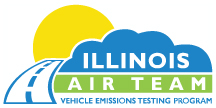
Your Resource
for the Illinois Vehicle Emissions Testing Program
About Vehicle Emissions Testing
What Vehicle Emissions Tests are Performed in Illinois?
An On-Board Diagnostics (OBD) test is used for most 1996 and newer passenger cars and light-duty trucks, including vans and sport utility vehicles, and 2007 and newer heavy-duty vehicles with a gross vehicle weight rating (GVWR) between 8,501 and 14,000 pounds.
How is the OBD test performed?
The OBD test consists of connecting a scan tool to a vehicle's on-board computer to determine the OBD system status (readiness checks) and whether the Malfunction Indicator Lamp/Light (MIL) is commanded on (in which case it would be illuminated), and to retrieve any stored diagnostic trouble codes (DTCs).
Vehicles will pass the OBD test if the OBD system is working, all required emissions system readiness checks have been completed and the MIL is not commanded on.
Vehicles will fail the OBD test if the MIL is commanded to be illuminated and DTCs are present. Vehicles will also fail if the OBD system is inoperable or if the OBD connector is missing, damaged or inaccessible.
For further information, refer to the “Understanding On-Board Diagnostics (OBD)” frequently asked questions page.